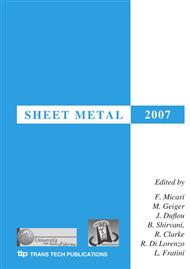p.9
p.21
p.31
p.39
p.47
p.55
p.63
p.71
p.79
On The Stability of Superplastic Deformation Using Nonlinear Wavelength Analysis
Abstract:
Optimum variable strain rate forming paths based on two multiscale deformation-based stability criteria are developed. The first criterion is based on Hart’s linear stability analysis while in the second criterion; we introduce a modified one dimensional nonlinear long wavelength analysis introduced by Hutchinson and Neale [7] based on the well known 2-D Marciniak-Kuczynski criterion. The stability criteria are calibrated for the AZ31 Mg alloy at 400 °C yielding two different variable strain rate forming paths. These paths show that the nonlinear wavelength analysis is more sensitive to strain rate sensitivity and results in larger attainable uniform strains than Hart’s approach especially at low strain rates. This result is demonstrated through finite element simulations of a deep rectangular box using pressure profiles derived from the two variable strain rate forming paths. The FE results clearly illustrate that Hart’s approach underestimates the amount of uniform deformation and therefore prolongs the forming time to prevent failure compared to the nonlinear analysis.
Info:
Periodical:
Pages:
47-54
Citation:
Online since:
July 2007
Authors:
Price:
Сopyright:
© 2007 Trans Tech Publications Ltd. All Rights Reserved
Share:
Citation:


